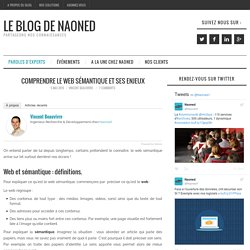

Comprendre le web sémantique et ses enjeux. On entend parler de lui depuis longtemps, certains prétendent le connaître, le web sémantique arrive sur (et surtout derrière) nos écrans !

Pour expliquer ce qu’est le web sémantique, commençons par préciser ce qu’est le web : Le web regroupe : Des contenus de tout type : des médias (images, vidéos, sons) ainsi que du texte de tout format.Des adresses pour accéder à ces contenus.Des liens plus ou moins fort entre ces contenus. Par exemple, une page visuelle est fortement liée à l’image qu’elle contient. Pour expliquer la sémantique, imaginez la situation : vous abordez un article qui parle des papiers, mais vous ne savez pas vraiment de quoi il parle. Votre imaginaire se met en marche au fur et à mesure de la lecture. Vous qui êtes intelligents, vous interprétez ce que cela peut signifier. On peut se demander pourquoi essayer de faire comprendre tout ça à des machines ? Pour être honnête, le web sémantique n’apporte pas réellement de sens, comme nous le faisons, nous, humain. Le Web sémantique. The Semantic Web Explained - The Technology and Mathematics behind Web 3.0.
The Semantic Web is a new area of research and development in the field of computer science, which aims to make it easier for computers to process the huge amount of information on the Web, and indeed other large databases, by enabling computers not only to read, but also understand the information.

This book is intended to be a textbook about the Semantic Web and related topics, and is based on successful courses taught by the authors. They describe not only the theoretical issues underlying the semantic web, but also practical matters (such as algorithms, optimisation ideas and implementation details) and this aspect will make the book valuable as well to practitioners. Supplementary materials available via the web include include source the code of program examples, and the syntactic description of various languages.
Sitographie. The Semantic Web of Data Tim Berners-Lee. Semantic Web - W3C. W3C - Semantic Web. Developpez.com - Web sémantique. Sitographie. Bibliographic Wilderness. I have been seeing an enormous amount of momentum in the library industry toward “linked data”, often in the form of a fairly ambitious collective project to rebuild much of our infrastructure around data formats built on linked data.

I think linked data technology is interesting and can be useful. But I have some concerns about how it appears to me it’s being approached. I worry that “linked data” is being approached as a goal in and of itself, and what it is meant to accomplish (and how it will or could accomplish those things) is being approached somewhat vaguely. I worry that this linked data campaign is being approached in a risky way from a “project management” point of view, where there’s no way to know if it’s “working” to accomplish it’s goals until the end of a long resource-intensive process.
I also think some of those advocating for linked data in libraries are promoting an inflated sense of how widespread or successful linked data has been in the wider IT world. 1. So. . …. Sitographie.